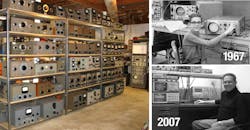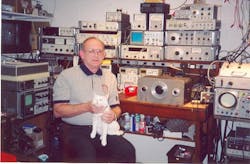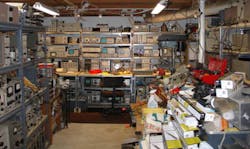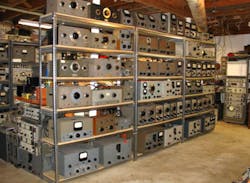Ken Kuhn (Fig. 1), an adjunct professor in the Department of Electrical and Computer Engineering at the University of Alabama at Birmingham, wrote Bob Pease back in January of 2006, “Just a quick note to make you aware of my web site devoted to analog electronics and history. Take the picture tour of my shop and museum (Fig. 2). This may be one of the largest home electronics shops anywhere. All of this vintage analog electronics is menu driven using analog GUI— the instruments perform the function the knobs point to. No programming required. Help menus not needed. I enjoy your column in Electronic Design— keep up the good work.”
1. Ken Kuhn with his cat in front of a working bench at his HP Museum in Alabama. (Courtesy of Ken Kuhn)
2. As an analog aficionado, Kuhn’s cache of cool test equipment also has Tektronix, General Radio, and lots of other old, classic test equipment. (Courtesy of Ken Kuhn)
Pease thanked Ken for the compliment about his articles and added an emphatic “That, I like!!” regarding the analog GUI (graphical user interface). After reviewing the website, Pease noted,
“In one paragraph you say, "There ought to be a book...." I saw the book about the 25 very best products of HP; that came out from HP, about a dozen years ago. Or was it 18 or 20? I bought and studied it and learned some. Do you have that book? I don't know where I put mine. It used to be good bed-time reading. Do you have a "Wanted List" of old HP instruments or Instruction Manuals? I, too, used to study the schematics of the new instruments such as Tektronix, HP, Data Precision, etc. etc. These days, everything is so computerized, and most of it, I hate. Menus, I hate. I prefer your analog gui. It's like analog PowerPoint. Hey, in a couple months, can I send people to your museum? There is also a Philbrick Archive, and I should also send people to look at that. Best regards. / rap”
Pease must have pored over Ken’s website again, since four hours later he wrote back, “Hello, Ken. That is a very nice museum! At first I was worried about those tall racks of equipment (Fig. 3), were just an invitation for an earthquake to knock them all down. But as you appear to live in Alabama, I guess they are safe. I hope you are not too close to that earthquake site in New Madrid, Illinois, or Missouri, or whatever. I guess you are at least 100 miles away, allowing for the size of Mississippi. Very nice work!!”
3. Bob Pease worried about the earthquake stability of these tall racks in Kuhn’s collection. Kuhn assured Pease that there were few earthquakes in Alabama, and the racks are laced to posts holding up the roof. (Courtesy of Ken Kuhn)
Kuhn wrote back,
“I live in Birmingham, Alabama so earthquake risk is minimal. However, the row of racks is going to be secured to the house posts (I think they are obscured in the picture) just for insurance.
“As for the HP book you mentioned. I am not aware of that particular one. However, there was an HP book that was published in 1983 titled, ‘Inventions of Opportunity: Matching Technology with Market Needs.’ This book was selected articles from the HP Journal. This book featured about 31 significant HP instruments. I have this book and it is excellent reading. That may be the one you are talking about. FYI: there are two books concerning the history of HP that are being written now and I guess will be published this year or next. One is a biography of Mr. Hewlett, Mr. Packard, and the company, and is being written by Michael Malone— a well-known author of books about Silicon Valley. The other book is being written by two former HP employees and will be more about the business.
“As for a want list for HP equipment, I do have a minimal list, I own most everything else. This list includes an HP204A oscillator and manual. This one was a battery-operated vacuum tube portable unit and is very rare. I have the more common HP204B, C, and D units. Also an HP200T oscillator. This is a special version of the HP200 series oscillators for telemetry testing. It is the only 200 series oscillator I do not have. I know there are a few more, but my mind is blank at the moment.
“I am interested in locating an HP803A VHF Impedance bridge and the HP417A VHF detector that goes with it. I have these in my collection, but HP is interested in acquiring this set for the archives. Last fall I was contacted by Art Fong in Palo Alto (see some article links about him on my web site page about HP persons) who was the engineer who developed these and he found them on my web site. He was working with Anna Mancini (HP corporate archivist) trying to locate these for a documentary HP was filming. I did not want to sell my units but offered to loan them for the film but deadlines ran out. Anna told me that HP still wanted to acquire a set. I said that I would watch for some to show up. I have checked every source I know but no luck so far— these units are very rare.
“Feel free to refer people to my web site. I can even give personal tours. One sales person from Agilent is planning to take the tour next time he is in town. Much more is coming for the web site as I have time, so check back from time to time to see new material. I enjoyed meeting you about two years ago when you were doing a National Analog Seminar in Huntsville. Hope to see you again someday. I am well-known and sought after locally for my analog electronics expertise. I was literally drafted many years ago to teach evening analog electronics at the University of Alabama, Birmingham. I have been doing that for about the last 18 years in addition to my day job. All for now, Ken.”
Pease immediately forwarded the thread to me and several friends. He noted, “Hi, guys, this memo includes his "Want List". I bet, even here in the Valley, it would be slim pickings to find such old stuff. I told him he ought to post a little "Wanted" section on his web pages. / rap”
I dropped a note to Kuhn to ask permission to run his pictures and quote him. He added:
“I really miss Bob Pease. He was my kind of guy. I have a number of emails with him and also got to meet him some years ago. I am now retired but am working practically full time on an interesting analog electronics project I was drafted into. I have an article in Electronic Design about Hall networks used to make notch and bandpass filters. There is also a pdf of the content on my personal website. I have been contacted by a few people who saw it and had interesting applications.
“I also operate the HP Memory Project, which was developed by a friend of mine, Marc Mislanghe, who worked for HP France. Sadly, he died in 2014 and I was drafted to take over the site. The site is huge with tons of data and memoirs of former HP engineers.
“One of the books that had not been published at the time of my correspondence with Pease is ‘The HP Phenomenon’ written by Charles House and Raymond Price. It was published in 2009 and I am mentioned in the book. I know Mr. House and provided some research for him. The Michael Malone book is ‘Bill and Dave.’ I met Mr. Malone and provided him some research too. Around 2007 I donated an HP417A and HP803A to the Agilent History Center. I also donated an HP200B oscillator to Stanford University and it is on display at the HP Garage exhibit at the Huang Engineering Center.
“I have had the pleasure of an inside tour of the famous HP garage and house. There are YouTube videos [check out one of them below] of presentations at the HP Corporate auditorium that my friends, Glenn Robb, Marc Mislanghe, and I did back in 2007 about our HP history work and websites. The Hewlett Packard Archive site operated by Glenn Robb also has a lot of HP information.”
I should also mention my friend and fellow tech writer Steve Leibson’s site about the HP 9825 desktop computer from 1977. The website has information on earlier and later HP computers as well. Leibson writes with the conviction of a former Colorado HP employee.
Stanford professor Tom Lee told me about HP giving a high school student an oscilloscope back in the 1960s. Kuhn knew all about that story and forwarded me a 2009 email titled “A heartwarming HP story.” It was by Ken Chalfant, the engineer who got the free ‘scope. Chalfant wrote:
“My story regarding Hewlett Packard starts in 1967 when I was a junior high school student, age 13. I was already totally focused on electronics, owned an EICO VTVM (vacuum-tube voltmeter), and was trying to save up money to buy a kit-form oscilloscope from HeathKit. My science class went on a tour of the local HP plant here in Colorado Springs, CO. Wall to wall, as far as I could see, were oscilloscopes and test equipment so far beyond fantastic that I almost had a seizure.
“When I got home I called out to the plant and asked if they had any used scopes for sale. ‘We don't sell our used equipment.’ came the answer. ‘How much is your least expensive scope in kit form?’ I asked. ‘We put all our equipment together, we don't offer kit form.’ was the reply, followed by ‘Would you like a catalog?’
“My mom took me out to the plant and I met Norm Hall, the local marketing manager that I had talked to on the telephone. He gave me a copy of their catalog. Oh my! What a catalog. It was nearly an inch thick of glossy pages stitched hard-bound into a beautiful book. I took it everywhere and wore it out. It was not only filled with their equipment, but a great deal of information on how their equipment worked and how to apply it. That catalog was my first electronics instrumentation text book. I still have that exact copy and I have also bought a pristine copy for my library.
“I was not ready to give up on getting an HP scope, so I wrote Mr. Hewlett a letter and asked him if I could buy a used one. Well, to keep a long story somewhat shorter, Mr. Hewlett gave me a 120B scope. Forty years to the month later, Agilent [now Keysight] rediscovered the story of what Mr. Hewlett had done for me. Jay Alexander, now CTO of Keysight, invited me out to the factory as a guest speaker to talk about Mr. Hewlett and the ‘old’ HP days, even though I have never worked for HP. Then they did it again— they gave me another scope (Fig. 4), an MSO6054A. Wow, what an amazing oscilloscope. I love it!
4. As a 13-year-old electronics lover, Ken Chalfant wrote Bill Hewlett asking to buy a used oscilloscope. Hewlett sent him a brand new one. Forty years later, Agilent (now Keysight) celebrated the occasion by giving Chalfant another free ‘scope. (Courtesy of Ken Chalfant)
“It’s amazing that a man I never met and a company I never worked for have had such a profound and positive impact on my life. Mr. Hewlett and several Colorado Springs engineers like Blair Harrison, the pulse generator lab manager who kindly tolerated me, giving me parts, and turning me loose to talk to his engineers at the plant, helped me so much when I was just a kid. Then after telling ‘my’ story and helping them remember how fantastic Mr. Hewlett and HP really were, they ‘framed’ my life by giving me another scope.
“Of course, I'm completely biased, but I doubt there will ever be two more significant and honorable business people then Mr. Hewlett and Mr. Packard. I don't think anyone will ever build a company that will contribute as much in technical terms and so much more in human terms than did Mr. Hewlett and Mr. Packard. Agilent [now Keysight too] still makes fantastic equipment and there are many wonderful, caring, involved people working there, but without Dave and Bill, Agilent is not, and never will be the old Hewlett Packard.”
After checking with Chalfant for permission to run his picture and words, he noted, “I have always been a little surprised, maybe humbled is a better word, that I have been blessed more than once by Mr. Hewlett’s kind generosity. In a small way the story is about me as a kid, but in a much bigger way the story is all about Mr. Hewlett. It really is an opportunity to gain insight into one of the two men who created the greatest company that will ever exist. By comparison I don’t think there are any great business leaders. Growing up, my peers envied sports heroes, rock-n-roll stars, and movie stars. I didn’t care about any of that. The one man I admired, and still do, is Mr. Hewlett.” Chalfant then added, “I still have, and will always have, that 120-B oscilloscope.”
Like Chalfant, I am biased as well. I consulted to the HP Automotive Systems Division back in 1998. The HP Way was alive and well, and it was one of the best jobs I ever had, with the best boss I have ever met. If any of the new HP entities, Keysight, or Agilent, or HP Enterprise, want to understand the fierce loyalty they have from engineers, they should think about how Bill Hewlett and Dave Packard treated a young junior high school kid from Colorado, and how they inspired college professors and others to document the company’s legacy (Fig. 5). That is how you build a brand.
5. Another working bench in Ken Kuhn’s HP Museum. Note the track lighting for the benchtop. (Courtesy of Ken Kuhn)
That Colorado Springs marketing manager giving a 13-year-old kid an expensive hard-bound catalog did not help that quarter’s revenue. Yet the long-term benefit to HP/Agilent/Keysight/HP Enterprise is nearly incalculable. That’s the difference between marketing and sales. More companies should learn that.
About the Author
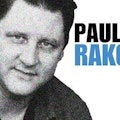
Paul Rako
Creative Director
Paul Rako is a creative director for Rako Studios. After attending GMI (now Kettering University) and the University of Michigan, he worked as an auto engineer in Detroit. He moved to Silicon Valley to start an engineering consulting company. After his share of startups and contract work, he became an apps engineer at National Semiconductor and a marketing maven at Analog Devices and Atmel. He also had a five-year stint at EDN magazine on the analog beat. His interests include politics, philosophy, motorcycles, and making music and videos. He has six Harley Sportsters, a studio full of musical instruments, a complete laboratory, and a video set at Tranquility Base, his home office in Sun City Center Florida.
